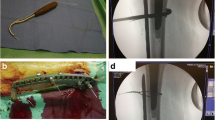Abstract.
Introduction: Increasing life expectancy is associated with an increase of geriatric fractures such as intracapsular femoral neck fractures. Their treatment by arthroplasty imposes a significant burden on our health care system. Methods: In an open clinical study we investigated the complication rate of a less expensive and less invasive, femoral head saving operative procedure. Between June 1997 and June 2000, 205 intracapsular femoral neck fractures of elderly patients (mean age 78.1 ± 11.8 years) were fixed with cannulated screws. Results: Seventy-seven percent were displaced fractures and 15.6 % were impacted Garden I fractures. Reoperation after internal fixation occurred in 38 patients. The most frequent cause of reoperation was secondary arthroplasty due to redisplacement (14×), femoral head necrosis (10×) and non-union (7×). Implant removal (4×), wound hematoma (1×) and femoral head penetration by screws (2×) were other causes for reoperation. Conclusion: Less invasive cannulated screw fixation of intracapsular femoral neck fractures should be considered as a treatment option, because it is a smaller and less expensive operation than prosthetic replacement. Adequate reduction and screw placement, however, are a prerequisite for successful outcome.
Zusammenfassung.
Einleitung: Die Zunahme der Lebenserwartung führt zu einer Zunahme von geriatrischen Frakturen, insbesondere der medialen Schenkelhalsfraktur. Die Behandlung mit einem endoprothetischen Hüftgelenkersatz verursacht hohe Kosten. Methodik: In einer offenen Beobachtungsstudie untersuchten wir die Häufigkeit und Art der Komplikationen nach einer kostengünstigeren, minimal-invasiven, femurkopferhaltenden Operation. Zwischen Juni 1997 und Juni 2000 wurden 205 mediale Schenkelhalsfrakturen bei betagten Patienten (mittleres Alter: 78,1 ± 11,8 Jahre) mit kanülierten Schrauben stabilisiert. Ergebnisse: 77 % der Frakturen waren disloziert und in 15,6 % der Fälle handelte es sich um eine eingestauchte Schenkelhalsfraktur. Bei 38 Patienten war eine Zweitoperation notwendig. Häufigster Grund war die sekundäre Implantation einer Prothese infolge einer Redislokation (14mal), Hüftkopfnekrose (10mal) oder einer Pseudarthrose (7mal). Weitere Gründe waren ein Wundhämatom (einmal), die intraarticuläre Schraubenfehllage (2mal) und Schmerzen, die zu einer Implantatentfernung oder einen -wechsel (4mal) führten. Schlussfolgerung: Die minimal-invasive Schraubenosteosynthese der medialen Schenkelhalsfraktur des betagten Patienten ist im Vergleich zur Endoprothese eine wenig belastende und kostengünstige Behandlungsoption. Die genaue Analyse der Frakturpathologie, die korrekte Reposition der Fraktur und Platzierung der Schrauben sind jedoch Voraussetzungen für den Behandlungserfolg.
Similar content being viewed by others
Author information
Authors and Affiliations
Rights and permissions
About this article
Cite this article
Bosch, U., Schreiber, T., Skutek, M. et al. Die minimal-invasive Schraubenosteosynthese der medialen Schenkelhalsfraktur bei betagten Patienten. Chirurg 72, 1292–1297 (2001). https://doi.org/10.1007/s001040170034
Issue Date:
DOI: https://doi.org/10.1007/s001040170034




